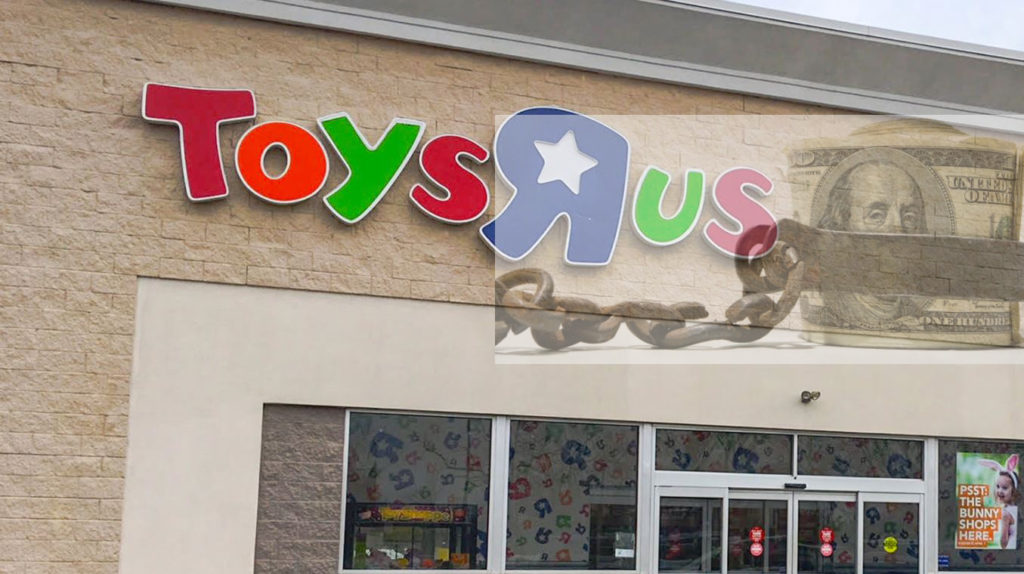Many blame lousy management, Amazon and the Internet for the demise of many stores and notably the recent announcement that Toys “R” Us is shuttering. The reality is much more complicated but shows we live in an economic system explicitly designed to allow a very few to use the American worker as pawns to make huge profits.
Dan Rather explains the Toys “R” Us financial debacle
It is shameful that the American economic system has allowed a few owners of capital to use its citizens as pawns to enrich a few as they did with Toys “R” Us. CNN reported the demise of the company as follows.
It marks the end for a company that sold toys, bikes, video games and birthday presents to millions of American kids. For half a century, Geoffrey the mascot giraffe invited children to its giant playhouses. Legions of adults who came of age in the 1980s and 1990s can probably still whistle the jingle: “I’m a Toys ‘R’ Us kid.”
Yet Toys “R” Us fell victim to the strong currents pulling specialty retailers into oblivion. Walmart, Target and other big-box retailers — stores that offered aisles of toys and everything else, too — began to erode its dominance. And then the emergence of Amazon sped its demise.
In another CNN article, the CEO conceded that the company had not kept up its stores. The piece had a critical statement we must expand on.
Don’t blame Amazon for the death of Toys “R” Us.
It’s true, online shopping didn’t help matters, but the struggles of Toys “R” Us predate the boom in online shopping. Many of its wounds were self-inflicted. The company’s biggest problem: It was saddled with billions of dollars in debt. That debt stopped it from making the necessary investment in stores. And that meant an unpleasant shopping experience that doomed the chain.
The article alluded to one of the primary reasons the company did not have the resources to make itself right.
Later the company was taken private by KKR, Bain Capital and real estate firm Vornado. The $6.6 billion purchase left it with $5.3 billion in debt secured by its assets and it never really recovered.
In other words, private equity companies performed a leveraged buy out of the company. What exactly is a leveraged buy out? Wikipedia has a comprehensive section on leveraged buyouts everyone should read.
A leveraged buyout (LBO) is a financial transaction in which a company is purchased with a combination of equity and debt, such that the company’s cash flow is the collateral used to secure and repay the borrowed money. The use of debt, which has a lower cost of capital than equity, serves to reduce the overall cost of financing the acquisition. The cost of debt is lower because interest payments reduce corporate income tax liability, whereas dividend payments do not. This reduced cost of financing allows greater gains to accrue to the equity, and, as a result, the debt serves as a lever to increase the returns to the equity.
Notice that there is no mention of employees or the economic benefits of the transaction to the economy or society at large, employment, wage increases, etc. Nothing. The reason why is that these are just mechanisms used by the titans of finance and capital to extract wealth from companies, vis-a-vis, the American worker.
The few provide a little capital and the bankers who do most of the financing extract the cash flow and worth of the company. It means that the company has so much debt to service, that it cannot use its cash flow and income to modernize or make necessary changes to the business to allow them to compete.
Amazon is just a huge store. And so is WalMart and Target. Toys “R” Us could just as well compete if it had the capital to improve its position on the internet and leverage its brick and mortar business. We must not the titans of finance, the people who create nothing for society, to fool us as they continue to rob the citizens with financial instruments many are too busy to spend the time to understand. This is partially the reason why the income and wealth of most Americans are stagnant or in decline.

